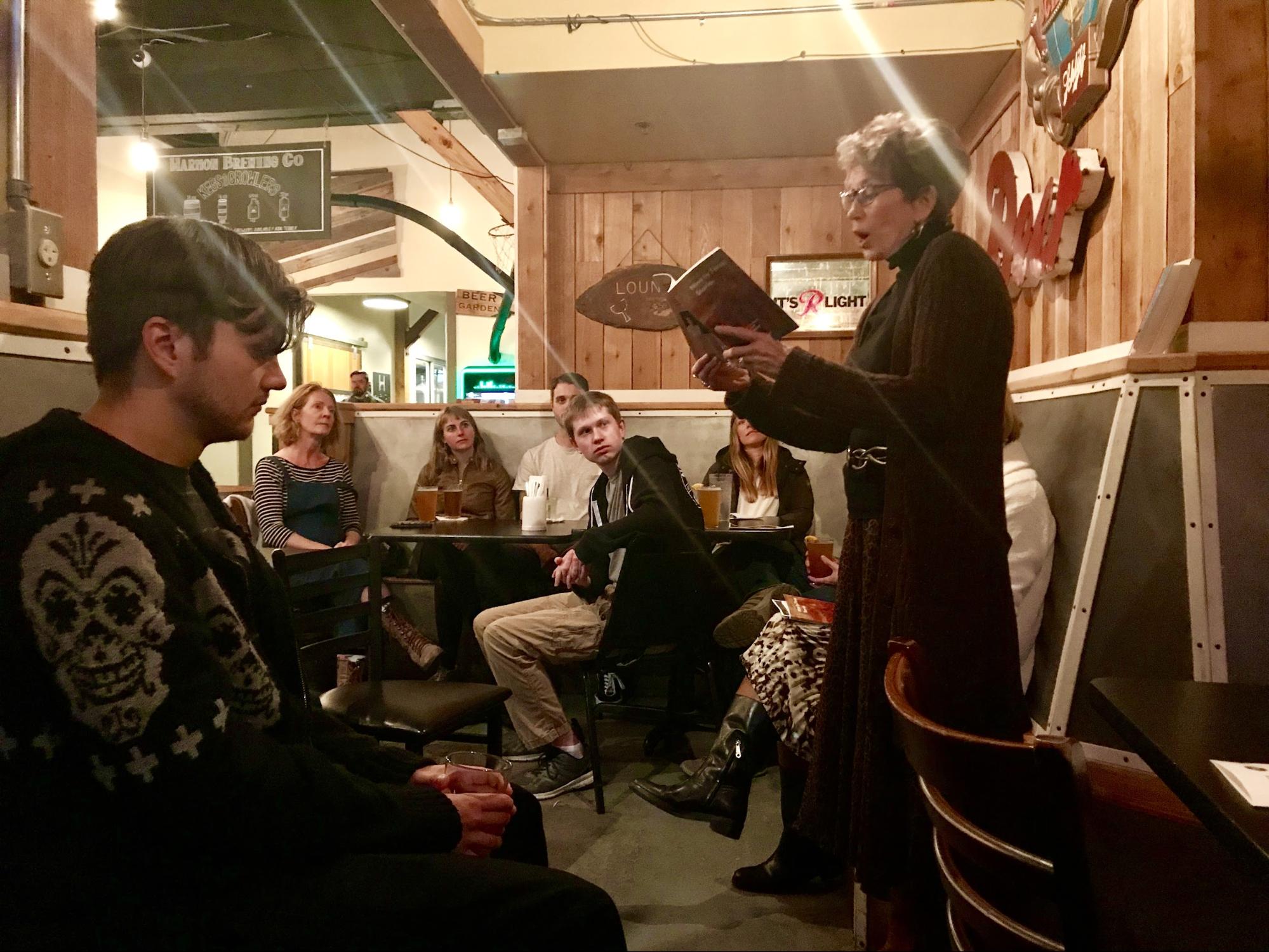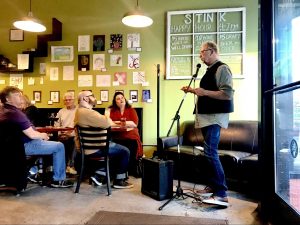

Come one, come all to the Creative Colloquy Crawl! If you’ve got the gall to tell a tale that’s tall, then go and answer the call for story-tellers big and small!
On Tuesday, Oct. 2 Creative Colloquy, an online literary site and collective based in Tacoma, hosted their fourth annual storytelling festival The Creative Colloquy Crawl. (Warning: Readers should not try to say this name 10 times fast lest they risk serious tongue based injuries.) According to their site, Creativecolloquy.com, the goal of the Crawl was to “present a matrimony of the written word, music and art to celebrate our rich creative culture.”
Spanning four hours across six different venues, it only took one look at the gatherings of artists and community members alike to see that the Creative Colloquy Crawl was a success. The Crawl featured artists and storytellers of all kinds, from historians and spoken-word poets, to writers and musicians. With over 13 different events to choose from, each offered its own unique insight into Tacoma’s creative community.
At STINK Wine and Cheese Bar, for example, community members gathered to listen to local historian Michael Sullivan and writer and essayist Tamiko Nimura tell true stories of Tacoma’s past. Sullivan recounted Tacoma’s hidden history as the birthplace of noir and detective fiction, a history which inspired the work of writer Dashiell Hammett.
Dashiell (then known as Sam) Hammett lived in Tacoma during the 1920s, a time when the city was, according to Sullivan, rife with violent crime and government corruption. The city went on to serve as major inspiration for the setting of Hammett’s famous hard-boiled detective stories, the grit and realism of which would go on to inspire Hemingway himself.
Tamiko Nimura told the story of Tacoma’s Japantown, a thriving Japanese-American community that resided in downtown. However, after WWII and the devastation of Japanese internment, many of Japan Town’s residents were forcibly removed from their homes and did not return. Because, as Nimura said, “How can you replace the soul of an entire neighborhood and entice the residents to return?”
Both Nimura and Sullivan’s stories spoke of broader work that was being done at STINK that night. “I’m writing because there’s a gap in the larger stories we tell ourselves about Tacoma,” Nimura said. “Writing this history feels like conjuring a place into existence again … Maybe this is the magic of history writing.”
Sullivan spoke on the impact of history as well; after his talk he told The Trail: “The idea in your mind of being a part of a shared memory with the people around you strengthens your sense of community and makes the culture of this city stronger.”
Indeed, the power of stories to strengthen a community was a salient theme throughout the night. Puget Sound Professor of English and Creative Writing Ann Putnam said that reading her work in front of an audience is “always joyful because it’s being shared.”
Her colleague, Professor Beverly Conner, who also shared her work that night, seconded Putnam’s statement when she addressed the crowd: “And this is so fun that you all came! You all came here of your own free will and that’s a wonderful thing.”
It was heartening to see the small crowd gathered in the lounge of Harmon Taproom, enraptured by the two women’s stories. Professor Conner relayed a heart-wrenching story of a young father who, after losing his son to meningitis, decides to participate in a bicycle ride for charity, only to become severely injured himself. His visit to the hospital forces him to come face to face with feelings of loss and grief that had been pushed aside for many years.
Professor Putnam’s story, on the other hand, followed a young anthropologist as she travels to Cuba and her revelatory experience with a Cuban Babalawo. When asked how she was able to so authentically capture the mysticism of the ancient ritual, Putnam told the audience at Harmon Taproom that the story was based off of her own lived experience:
“It was one of those experiences that I hadn’t expected to have in Cuba and I did, and after that it was just embedded in my mind. And I think it kind of — and I hate to say this — but it almost wrote itself in a way.”
Both Putnam and Conner’s stories can be read in the collection “Nine by Three: Stories,” a joint anthology featuring nine stories by three authors, the third being Hans Ostrom, who was unable to attend the event. The anthology is available for purchase on Amazon, as well as the University bookstore.
Another Colloquy gathering took place in The Mix, a boppin’ LGBTQ+ bar in downtown Tacoma, which featured works from a series titled “First. Only. Different.” (FOD).
According to the host, the series was titled after the simultaneous recognition and alienation experienced by talented people who are different than everyone around them.
The first performance within the FOD series was spoken-word poetry by Thy Nguyễn. Nguyễn, Tacoma poet laureate from 2015 to 2017, is a queer first-generation immigrant from Vietnam, according to her website. Nguyễn is a self-described “spoken word artist-singer” due to the multimedia quality of her poems which include both poetry and song.
Nguyễn’s second poem, “Photoshop” focused on an instance in which she was photographed by the City of Tacoma as a poet laureate. The city-appointed photographer photoshopped her without her knowledge or consent. She dedicated “Photoshop” to the City of Tacoma, as well as anyone who has ever felt erased due to digital modification.
“The camera, his gun in the mission of cultural imperialism. He shoots me till I’m only image,” Nguyễn recited.
Nguyễn was also one of the performers in the Friday Arts Night at the Race and Pedagogy National Conference, which senior Sarah Putulin attended. Nguyễn’s moving message combined with her powerful vocals led Putulin to Nguyễn’s performance at the Mix.
All of Nguyễn’s poetry can be found on her blog: thynguyen.org.
Assistant Professor of African American Studies and recipient of the 2018 National Endowment for the Arts fellowship Dr. Renee Simms was the second act of the “First. Only. Different.” night in the Creative Colloquy.
“I feel like I can’t tell one story about a giant mustard penis because it’s not about a mustard penis only, but about all of these incidents together, in context, and through time,” is the first line of the eponymous story “Meet Behind Mars,” one of two stories Professor Simms read from her collection of stories “Meet Behind Mars.”
“Meet Behind Mars” is told throughout a series of voicemails and letters exchanged between Simms’ protagonist, Gloria Clark, and several teachers and administrators at her son’s school. The story non-chronologically details the increasingly absurd reasons for which Clark’s son was suspended or given detention.
In one instance, Clark’s son was given after-school detention for bringing a weapon to school. The weapon in question? A nail file, and it wasn’t even him who brought it in.
Clark became steadily more frustrated as her son’s math teacher continually accused him of not having done any homework, while the teacher himself refused to respond to any emails regarding the condescending and racist undertones within his letters.
The voice of Clark moves fluidly between nonplussed and un-amused at the microaggressions presented to her for daring to live in a white suburb as a black woman.
Professor Simms’ book is available at the University of Puget Sound’s Bookstore and at most book retailers near you.
All in all, The Fourth annual Creative Colloquy Crawl was not only a total ball, but quite a thought-provoking sprawl! If stories are what you enjoy, the Crawl’s a community event for every girl and boy.
